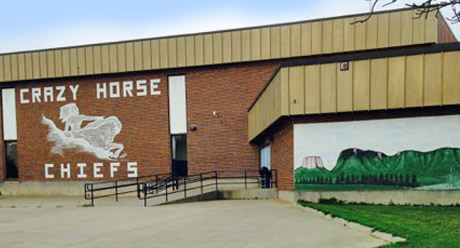Our History

Crazy Horse School
In the early 1960's, Wanblee, South Dakota, had no high school for students to attend. Parents were required to send their children to boarding schools such as Holy Rosary and St. Francis. The parents wanted to keep their children here. As a result, a group of community members marched from Wanblee all the way to Billy Mills Hall in Pine Ridge to speak with Robert Kennedy about their cause. When the marchers arrived, Robert Kennedy met with them and listened to their concerns. Shortly thereafter, these community members began work on designing and building Crazy Horse School.
Today, Crazy Horse School continues to offer a quality, culturally based education to the students of the Wanblee/Eagle Nest District. The school is located just off highway 44 in Wanblee, SD and offers a variety of classes and experiences.
Crazy Horse - The Man
Crazy Horse was known at the defender of the Black Hills and of his people. Crazy Horse was the greatest warrior of the Lakota people. He fought many enemies of the Lakota people from Pawnee, Crow and Whites. Anytime he would get ready for war others would get excited as his war parties where always successful. He was always ready to come to the aide of his people and defend them.
A quiet, compassionate man when he was not on the battlefield, he never wore any eagle feathers. The only feather he wore was that of a Red Tailed Hawk feather. Crazy Horse never let himself be photographed, though he was described to be a light complexion man, with gray eyes and brown curly hair.
Crazy Horse first took a scalp when he was just 14 years of age. From here he would soon have a scalp shirt with over a hundred scalps. During what many call the Red Cloud Wars Crazy Horse made a name for himself. The Red Cloud War started when the Bozeman Trail was created and cut through land that was the property of the Lakota. When forts and travels started to interfere with areas where hunting normally took place, Red Cloud started to attack. Crazy Horse fought many of these battles during this time. Some have made it into the history books such as the Battle of Kills One Hundred, though the history books call this Fettermans Massacre. The battles continued and lasted until in 1868 the Fort Laramie Treaty was signed and the forts where shut down.
Crazy Horse never signed any treaty. He never believed the whites would honor them. When many of the bands of Lakota started to settle down near forts, Crazy Horse remained out riding across the reservation. Later, bands were told to return to forts or be considered hostile. Still he remained riding across the plains. During June 1876 while a great encampment of Lakota where camped, General Custer attacked the camp. Crazy Horse lead a charge against the Cavalry. He rode back and forth taunting them to shoot at him. He has the power to be untouchable to any bullet fired at him. This battle was the greatest defeat in US history. The United States lost and dropped their flag to the Lakota people.
The prolonged war and battles started to take its toll on Crazy Horse's people. Their moccasins had holes on their soles, and their tipis were in need of repairs. He looked at his people and took pity on them. He decided to surrender and he moved his people around the northern Black Hills. He followed along the Cheyenne River and across part of the western edge of the Badlands. His people honored him as they rode into Fort Robinson signing a song.
Crazy Horse surrendered at Fort Robinson while many of the officers wanted to take him away to answer for his crimes. When the guardsmen came to take him in a struggle broke out. One of his friends and allies grabbed him and held him. A soldier then came up behind him and stabbed him. The stab wound punctured his kidney and he died later that night. His mother and father took his body and headed away to place his body where no one would find it.
To this day, Crazy Horse was known as the defender of his people and the greatest warrior to have lived.
written by: Mike Curran, Lakota Teacher

Chief Crazy Horse
